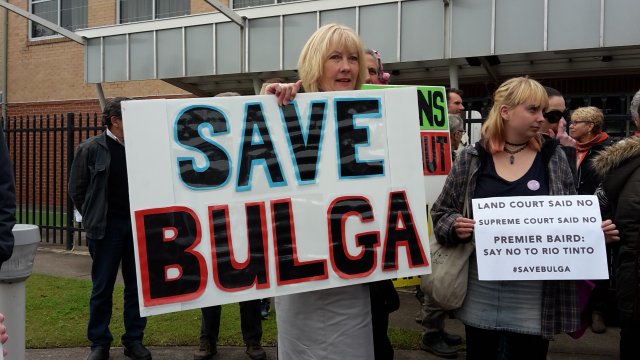
There is standing room only at Singleton Diggers Club. People in hi-vis vests take turns with supporters of the village of Bulga giving short speeches to a panel of commissioners of the Planning Assessment Commission (PAC). At stake is the extension of a Rio Tinto coalmine.
If it gets the green light, Saddleback Ridge, which buffers Bulga from the present noise and coal dust, will go. The 110 Aboriginal sacred sites will go. The amenity of rural life for the people of Bulga-Milbrodale and their belief in justice will go.
The world is watching this test case because Rio Tinto’s case has already been rejected by two courts. The Land and Environment Court and the Supreme Court both said no. So the state government changed the conditions of approval.
Now the economic argument trumps all other considerations; such as whether extending this mine will make life intolerable for the neighbours, whether the emissions from the exported coal will make life intolerable globally or whether the final void when added to all the other Grand Canyon-sized voids in the Hunter Valley will pollute the aquifers forever.
The premier is reviewing these conditions of approval. But will the PAC commissioners wait until the environmental and social impacts of any project are given equal weight with the economic benefits?
Most of the 120 speakers paid respect to the traditional owners of the land. Wanarua traditional owner Kevin Taggart said: “It’s a modern day invasion”. He said he had a “sacred responsibility to never give up”.
Another Wanarua man said he hoped to walk in the Warkworth sands area with his son where ceremonies, corroborrees and initiations had been performed long before white settlement.
Local historian Stewart Mitchell, whose pioneering ancestor had witnessed the last Bora ceremony at Bulga in the 1820s, said about 600 tribal people had gathered from miles around. His records describe the magnificent occasion.
Rio Tinto now owns this land. They had given an undertaking to preserve it in perpetuity but now they intend to mine it before the climate conscious world turns its back on coal.
Mark Rodgers, from Mt Thorley and Warkworth Mine, spoke of the 1300 people employed. He described the flow on of $1.5 billion in royalties and taxes to the NSW government and the benefit to the Singleton Council area. He said the mine could co-exist with the village of Bulga. His vision of providing jobs, offsetting biodiversity loss and “attenuating the noise” of the mine for 30 years, was backed up by many speakers.
There is 15% youth unemployment in Singleton and the picture of secure employment with a caring employer was compelling. We heard that Rio Tinto is a good employer of Aboriginal people, how women had good conditions and how leave to look after sick relatives was amply given. Yet they are building something that will be called the final void.
The bigger picture was presented by Holly Creenaune of Land, Water, Future. Coal is in structural decline. The present approval process does not consider the climate impact of coal exported by Rio Tinto. The cumulative impact of the hundreds of Final Voids filling up with tainted water in the Hunter Valley has not been researched. “We have long passed talk of co-existence,” she said.
Can they rehabilitate the mine back to productive land?
George Wood from Lock the Gate Alliance said: “Until they prove they can grow a forest they shouldn’t be allowed to knock over another one”. Peggy Fisher said: “If they can’t afford to fill these voids, they can’t afford to dig them out”.
Rod Campbell, from The Australia Institute, said the economic case for this proposal was weak, the benefits have been overstated and the costs understated. One example is the health burden of coal: $47 million each year for Singleton alone. James Wheelan of Environmental Justice Australia said the long-term exposure to coal particulates is very serious and many speakers called for compensation for the health stress so far.
So why would Rio Tinto want approval to mine more coal? Rod Campbell said: “If you approve, Rio Tinto will sack people and put the mine on go-slow”. Approval will enable them to defer their liabilities for retrenchment and rehabilitation and “I will have no pleasure in saying I told you so”.
Contact the PAC at to ask them not to present their report before the new conditions for mining approvals are in place.
Hear the full story of Bulga v Goliath in a radio show or for more information contact radioteam@bze.org.au.
Like the article? Subscribe to Green Left now! You can also like us on Facebook and follow us on Twitter.